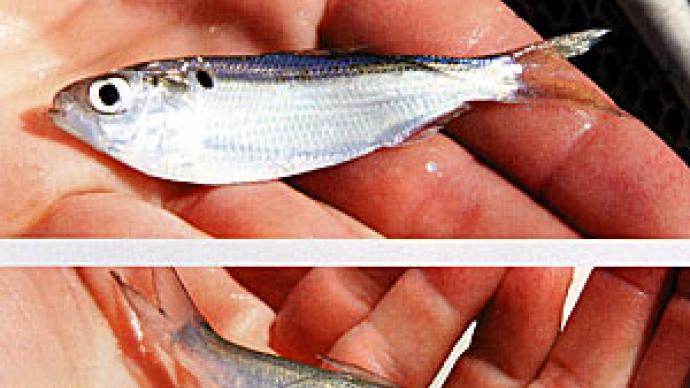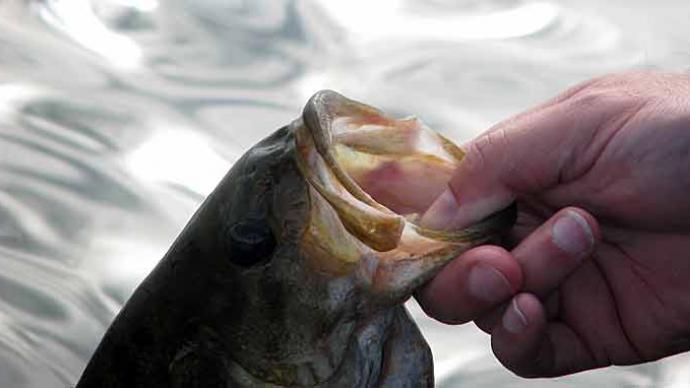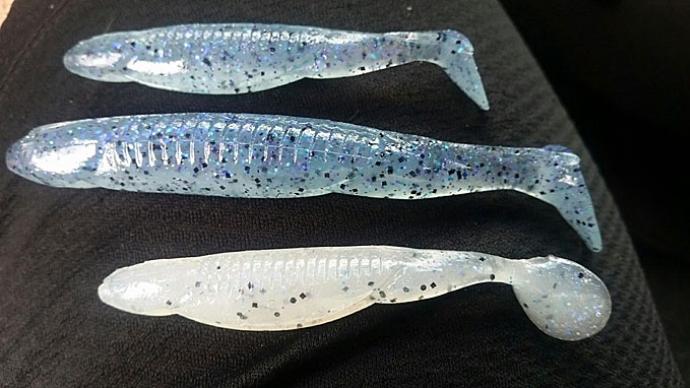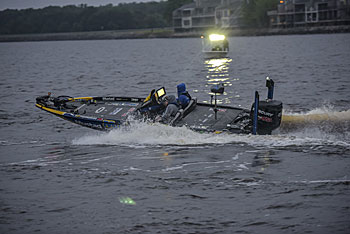
When the calendar turns toward the middle of April, you’ll need an early bedtime and cups of strong coffee to keep up with Bassmaster Elite Series angler Brandon Lester. That’s because the shad spawn will be in full swing on lakes around his Fayetteville, Tenn., home. It’s a buffet for bass, which rush the baitfish tightly packed along the surface in the shallows. While that happens over two to three weeks, its daily duration is short. “You have to ensure you’re right there at daylight,” he said. Most days, it’s over in about 90 minutes. “Though, it can last longer on a cloudy day,” he said.
Most of the bass that U.S. anglers chase swim in lakes with threadfin and gizzard shad. Their seasonal movements, such as schooling on deep creek and river channel ledges during summer, dictate where you’ll find the bass. They eat both, though gizzard shad grow to a size that even large bass can’t stomach. Both spawn at about the same time in the same places.
To catch the most bass during the shad spawn, you’ll need to be prepared beyond setting the alarm and prepping your coffee maker. Like other patterns, you’ll need to know what to look for, where to go and what to use. Here’s how Lester handles it.
When
Tims Ford Reservoir, an almost 11,000-acre Tennessee Valley Authority impoundment on the Elk River in south-central Tennessee, is Lester’s home lake. It’s filled with largemouth and smallmouth bass, and they spawn before the shad.
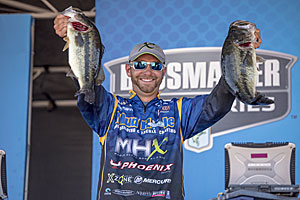
Several factors determine when the bass spawn, but the most important is water temperature. Lester said the bass spawn is underway once it’s in the 62- to 64-degree range. Not all bass spawn at once. A typical year will see the most during a full moon; some anglers believe the biggest bass spawn first. Some stragglers will spawn when the water temperature is much warmer, but you’ll find them on the main lake or in the deepest water, where sunlight can still warm the bottom. Most bass finish spawning within two to three weeks of the first one, he said, at least in lakes around his home, which is a few miles west of Tims Ford.
Once the water warms into the 68- to 70-degree range, Lester said the shad start spawning. While it lasts the same amount of time, the shad spawn starts later the farther north you travel from Tennessee and earlier the farther south. And much like bass spawning, it happens in waves. “There will be days when it’s much more prominent,” he said. He’s not exactly sure why that happens, and most likely, only the shad know for sure. He said it could be related to the weather, such as warming trends and barometric pressure changes.
That’s how bass and shad spawning proceeds during a typical year, but 2017 has been anything but ordinary. A mild winter across much of the country accelerated the timetable. Water temperatures typically seen in May were recorded in March. “This year, it’s almost like the shad started spawning while the bass were still spawning,” Lester said.
That spawning shift was on full display on Tennessee’s Lake Chickamauga during the third week of April, when the water temperature was 70 to 72 degrees. Lester competed in the Bassmaster Southern Open, catching 51 pounds and 4 ounces and finishing eighth. His daily game plan started with chasing bass feasting on spawning shad. Then he would sight fish for spawning bass in the afternoon when he also came across spawning bluegill, which usually makes beds during the dead of summer.
Where
Shad, don’t spawn everywhere. They have their favorite situations, just like bass seek out a hard bottom in protected water. “They like to be close to the bank most of the time,” Lester said. When the water temperature is right, he rides along in his boat, looking for spawning shad flickering on the surface. He also keeps his eyes open for wading birds such as herons. “That’s always a telltale sign,” he said. The fish-eaters hang around spots for one reason — food.
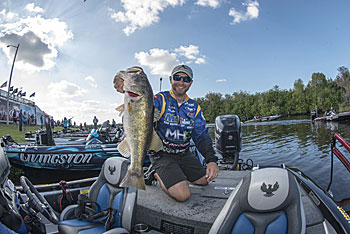
Shad spawn where cover and the water’s surface meet. They will spawn on aquatic vegetation, including beds that grow far from shore. Without that, they look for hard cover along the shoreline. The most well-known is riprap. Lester said shad also spawn on seawalls and docks. And don’t bypass overhanging trees, mainly willows. He has seen shad spawn among green branches that dip into the water.
Lester said shad would spawn around marina docks, even those suspended over open water. He believes the amount of overhead protection — covered slips, docks, and moored boats — gives them enough security to do their business. He said to look for them around the dock floats, especially black ones, which hold more heat and warm the surrounding water.
What
The shad spawn provides fast fishing action. Bass are aggressive, rushing schools of shad and busting them on the surface. “If you can see a bass run a ball of shad on the bank, you can catch it,” Lester said. “Even the ones quietly swimming around and not actively feeding can be caught in short order.” That makes it prime time for moving baits that draw reaction strikes.
Topwaters are Lester’s favorite type of lure during the shad spawn. They best imitate spawning shad and the commotion they make on the surface. His favorite is a walking lure such as a Heddon Zara Spook or Lucky Craft Sammy. Poppers, such as a Storm Chug Bug, are a good choice, too. And if there is aquatic vegetation where you’re fishing, he said it’s hard to beat a white frog. All of these can be fished quickly. You don’t have to convince these bass to strike.
Other lures work during the shad spawn. Spinnerbaits with two or more willow-leaf blades that weigh ½- or ¾-ounce and shallow diving square-bill crankbaits also are good choices. Lester said many competitors used swim jigs to target bass chasing spawning shad during the April 2017 Elite Series tournament on Mississippi’s Ross Barnett Reservoir. If you use a swim jig, pay close attention to its trailer. Double-tail grubs and chunks with wedge-shaped flappers are the most popular because of their exaggerated action.
Once the sun rises, the shallow shad spawn bite sets, and so will improve the effectiveness of moving lures. But that doesn’t mean you can’t catch more bass in the same areas. You have to choose a slightly slower shad-imitating lure that you can present deeper in the water column. Small swimbaits fit that bill.
While swimbaits come in various sizes, from less than 1 inch for panfish to more than 1 foot for California’s big bass, use ones 5 inches or shorter during the shad spawn. Lester prefers 4.5- to 5.5-inch models. Anything longer he feels is out of a smallmouth’s wheelhouse. Solid and hollow-body versions will work, but choose one that slims down before connecting to a sizeable boot-shaped tail. That will create the most action.
Work your swimbait around the same pieces of cover you fished earlier in the day with a topwater or spinnerbait. You’ll want to Texas rig it with a hook with a gap wide enough to handle the swimbait and hook a bass. Use a hook with a molded weight if your swimbait won’t track straight or rides too shallow on the retrieve.
Lester starts fishing a swimbait as the shad spawn is winding down and continues to do so as bass and shad migrate to the offshore spots where they’ll spend the summer. He focuses on slow tapering gravel points not far from where the shad spawned. He’ll usually keep his boat at least a good cast off the bank. “They’re not anything special,” he said. “I don’t have scientific proof, but it might be the shad are roaming around out there, too.”
Lester rigs his swimbaits on a jig head. He nearly always ties on one that weighs 1/8 ounce, but he’ll reach for a 1/2- or 3/4-ounce model during the rare times when he is fishing deeper. His retrieve is always slow and steady; he’ll let it sink to the bottom when it hits the water if snags aren’t a concern.
Swimbaits come in every pattern and color imaginable. But that doesn’t concern Lester. “I don’t get real worked up about color,” he said. He always chooses one that mimics a shad and then adapts that to the water color. He'll choose more translucent colors if it’s a bright day or the water is clear. If it’s a dark day or the water has some color, he’ll lean toward a brighter color, such as white or something with a touch of chartreuse.
Gear up
Even though the swimbait and its jighead are on the spectrum's lighter side, Lester still reaches for a baitcasting rod. He doesn’t want a pool cue, but one about 7 feet long and has a medium-heavy action. He attaches a reel with a gear ratio between 6:1 and 7:1, so he doesn’t work his swimbait too fast yet has enough line retrieval rate to catch up with a bass that runs at his boat. He spools it with 15-pound test fluorocarbon line. Its lack of stretch ensures a solid hook set.


